25 Best Things To Do In Brussels For First Time Visitors
Looking for the best things to do in Brussels? You’ve come to the right place!
As an avid traveler and sightseer, I’m always trying to figure out which attractions are worth visiting with my limited travel time. When I took a weekend trip to Brussels, I spent hours researching and planning my itinerary and came up with this list of the best attractions in Brussels.
This is no cookie-cutter “things to do in…” list. I’m not trying to overwhelm you with an extensive list of everything there is to do in Brussels. Instead, this curated list is ranked to help you decide which attractions are worth your time, or not.
So, starting from the best, let’s dive into the top things to do in Brussels.
Please note this post may contain affiliate links. If you click on one, I may earn a small commission at no extra cost to you. See my Privacy Policy for more information.
Best Things To Do in Brussels
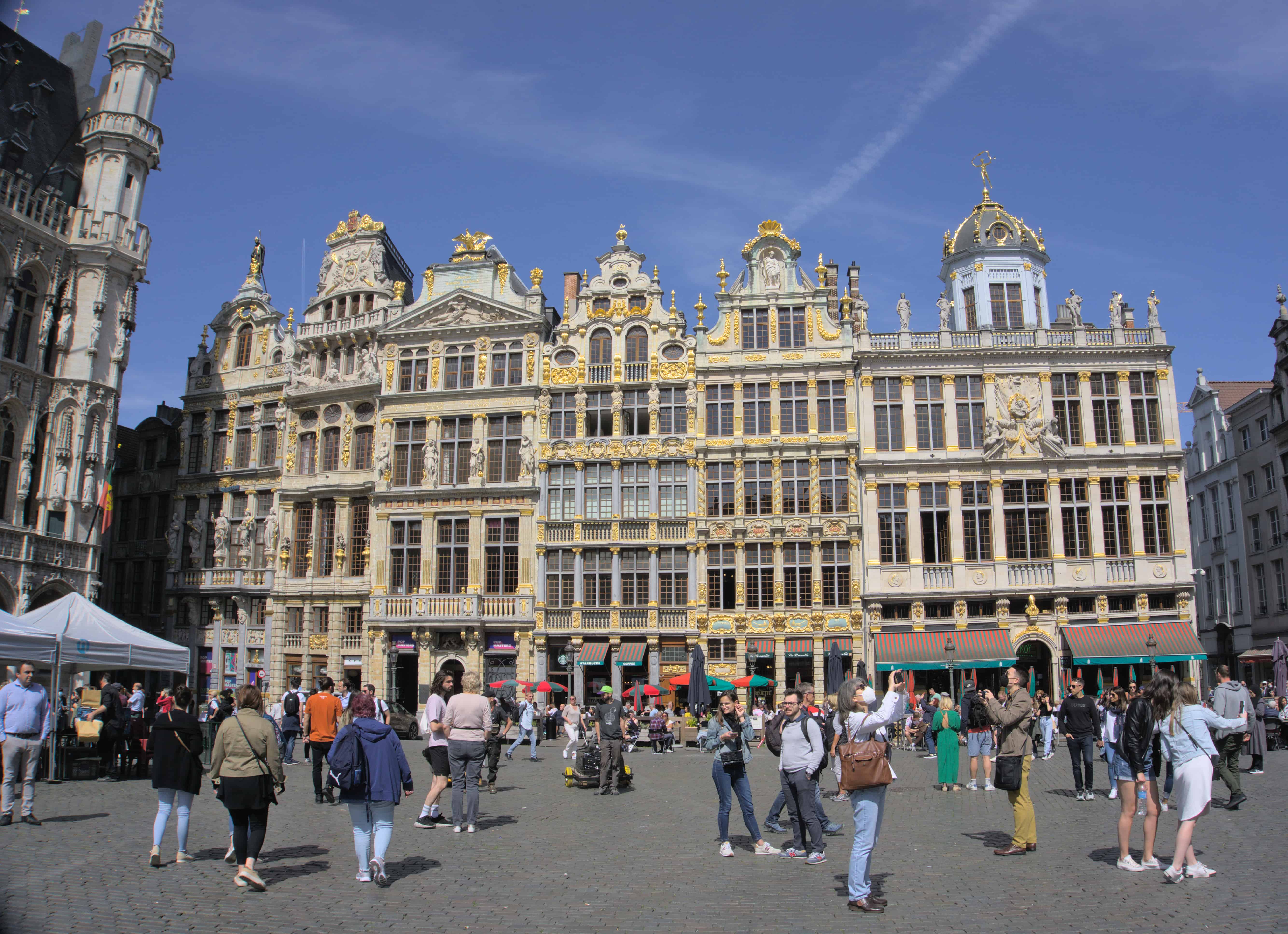
1. Visit Grand Place
If you only have time to visit one place in Brussels, make it the Grand Place. This UNESCO World Heritage site isn’t just Brussels’ main square, it’s widely considered one of the most beautiful squares in all of Europe, and for good reason.
Construction of the square began in the 11th century. Grand Place was originally a merchants’ market and is sometimes still referred to by its Dutch name, Grote Markt, meaning “Big Market”.
The square was mostly destroyed by the French in 1695 during the Nine Years’ War, then rebuilt and modified over centuries to its current appearance.
Today, it’s surrounded by opulent guild halls, the impressive Brussels Town Hall, and the Museum of the City of Brussels. The ornate gilded Baroque and Gothic architecture glitters in the sunshine and awes millions of visitors each year.
When visiting Brussels, try to come to Grand Place during the day so you can appreciate the architectural details and the sunlight bouncing off the gilded buildings, then return at night when the buildings are illuminated.

2. Royal Musée des Beaux-Arts
This one is for all the art lovers out there. The Royal Museums of Fine Arts houses not one but six separate art museums, making it one of Belgium’s largest and most impressive cultural institutions.
The collection spans from the 15th to the 21st century and includes masterpieces by Flemish artists like van Eyck and van der Weyden, as well as works by Bruegel, Rubens, and Magritte. In fact, the Magritte Museum within the complex houses the world’s largest collection of the surrealist master’s works.
The museum does an incredible job of telling the story of Belgian art through the centuries. The Old Masters section alone is worth the price of admission, but if you have the time, don’t miss the more modern collections.
Plan to spend at least 2-3 hours here, and purchase the optional audio guide to get the most out of your visit.
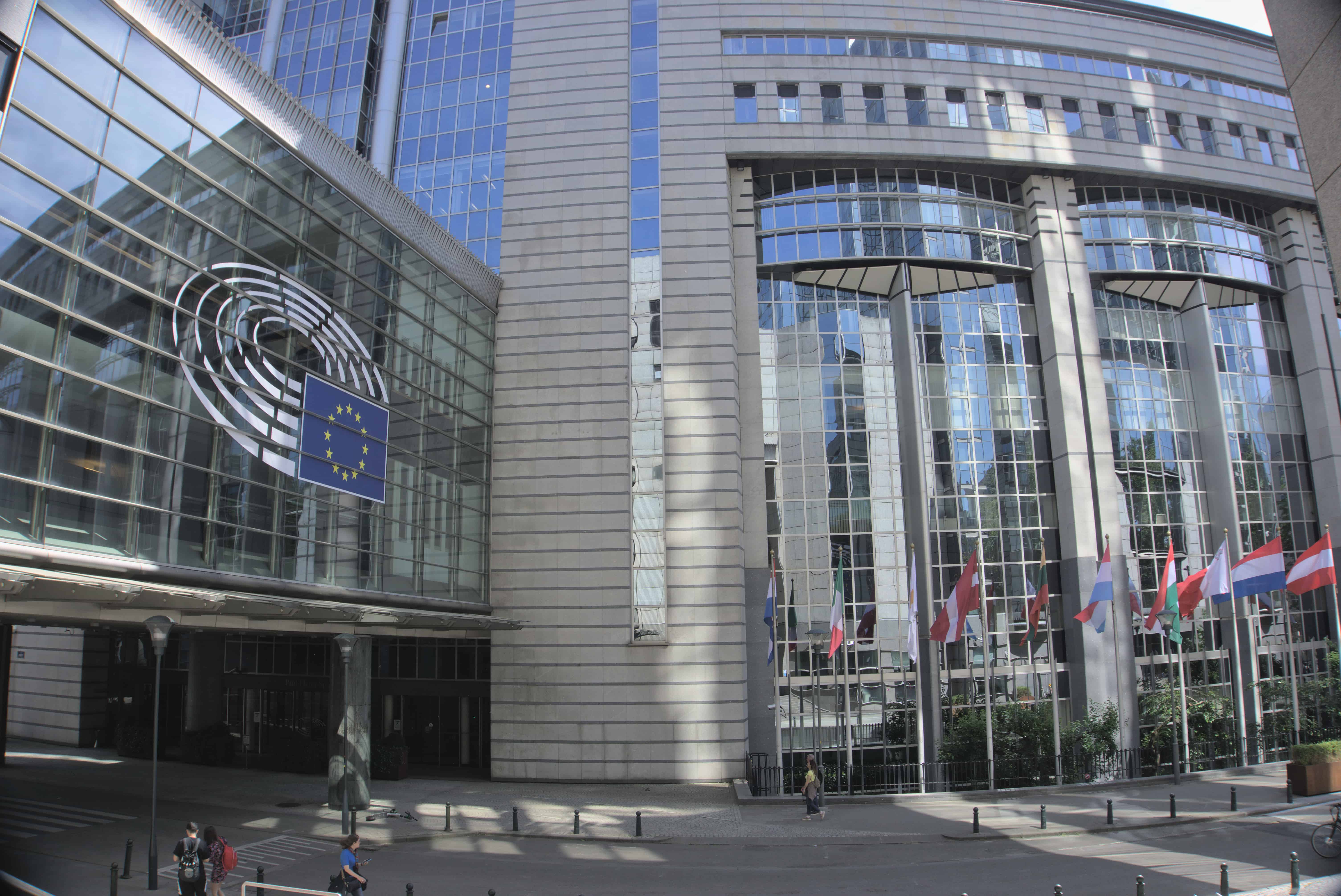
3. Tour the EU Parliament
Brussels isn’t just Belgium’s capital, it’s also considered the “Capital of Europe” due to its role as headquarters for the European Union. One of the most interesting things you can do in Brussels is take a tour of the European Parliament and learn how this massive democratic institution works.
The Parliament’s home is the striking Espace Léopold complex. Inside, you can visit the impressive hemicycle where the 720 MEPs debate and vote.
What makes this tour particularly interesting is learning about the practical challenges of running a multilingual democracy representing 27 countries. The Parliament operates in 24 official languages, requiring a small army of translators and interpreters.
Tours are free and include the Parlamentarium, an interactive visitor center that brings EU politics to life through multimedia displays. If you’re coming to Brussels on the weekend when the EU Parliament is closed you can still visit the Parlamentarium.

4. Galeries Royales Saint-Hubert
Long before modern shopping malls, there were the Galeries Royales Saint-Hubert. Opened in 1847, this stunning set of 3 glass-roofed arcades was one of Europe’s first shopping galleries.
The design by architect Jean-Pierre Cluysenaar was revolutionary for its time, creating a light-filled space protected from Belgium’s notoriously rainy weather.
The galleries served as a meeting place for the city’s elite and intellectual circles. Victor Hugo and Alexandre Dumas were known to frequent the cafés here. When you visit today you’ll find luxury boutiques, chocolatiers, jewelers, bookshops, and historic cafés.
Don’t miss the chance to sample pralines at Neuhaus or people-watch at one of the cafés. Even if you’re not shopping, the architectural beauty makes this a must-visit.
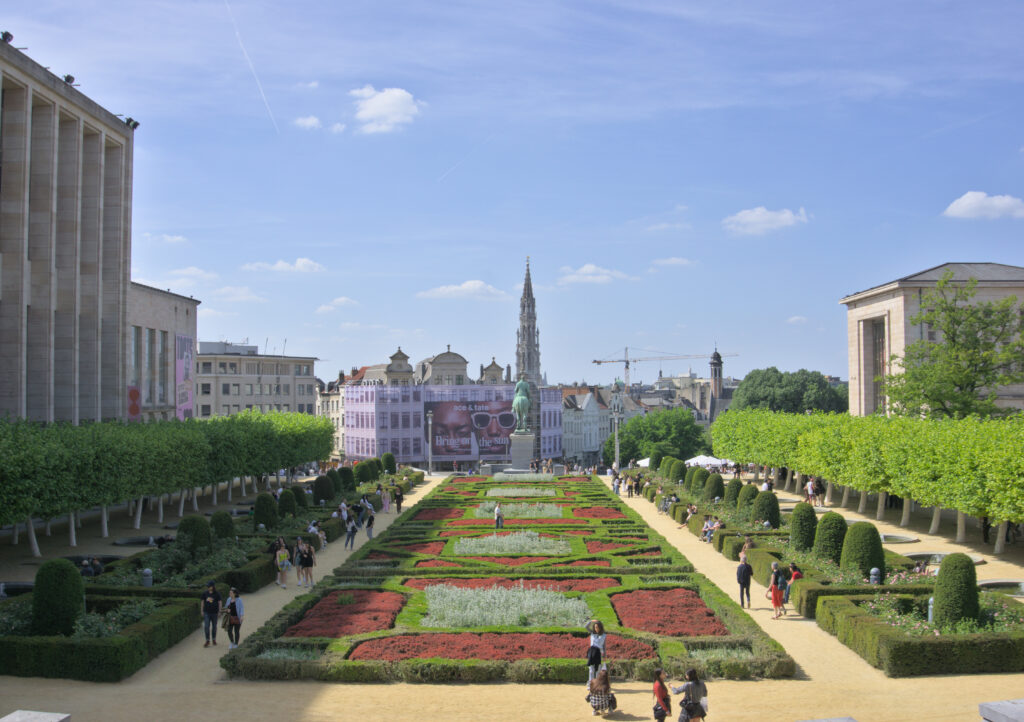
5. Mont des Arts
If you’re looking for views, head to Mont des Arts. This beautiful space offers the perfect blend of culture, history, and stunning city views.
This elevated garden complex connects the upper and lower parts of the city. It’s surrounded by important cultural institutions, including the Royal Library of Belgium, the National Archives, and the Brussels Meeting Centre. The gardens themselves feature fountains, sculptures, and manicured flowerbeds.
From the central balcony, you’ll enjoy what might be Brussels’ most photographed vista: a sweeping panorama that includes the spire of City Hall, the dome of St. Michael and St. Gudula Cathedral, and on clear days, the Atomium in the distance.
What I love about Mont des Arts is how it tells the story of Brussels’ urban development. The site was once a densely populated neighborhood that was demolished to create this cultural center, a controversial transformation that reflects the city’s complex history of urban renewal.
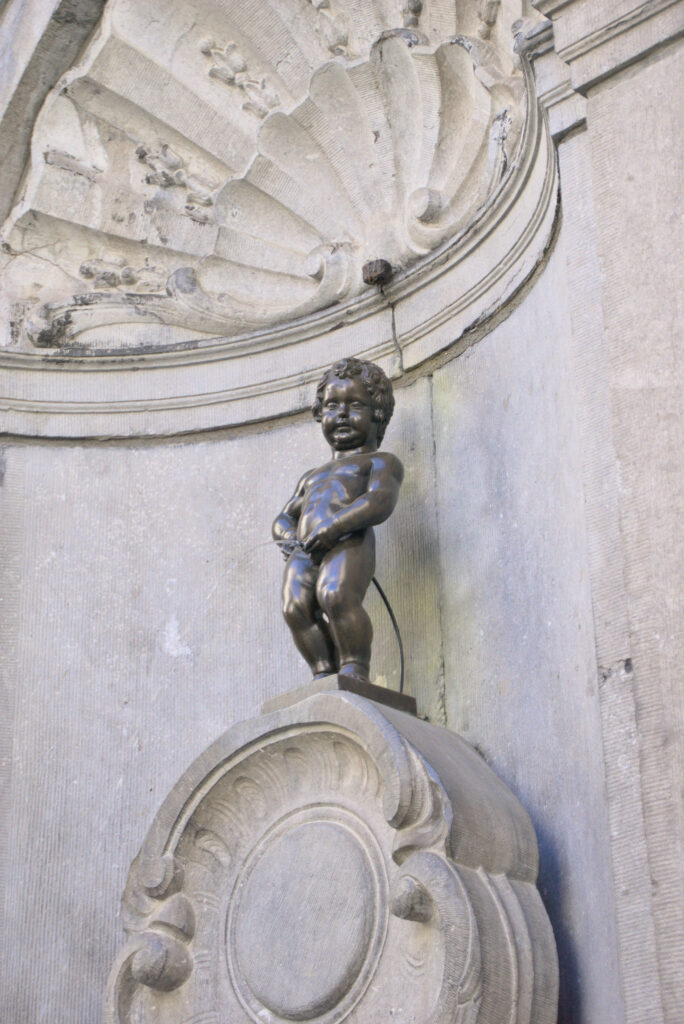
6. Manneken Pis
He’s tiny, he’s famous, and yes, he’s constantly relieving himself.
The Manneken Pis may be Brussels’ most overhyped attraction. Still, this small bronze fountain sculpture of a urinating boy has become the quirky symbol of the city’s irreverent sense of humor.
Dating back to 1619 (though the current statue is a replica), Manneken Pis has numerous legends attached to it. My favorite is the one about a young boy who saved the city by urinating on a burning fuse that would have exploded the city walls during a siege.
What many visitors don’t realize is that the little guy has a wardrobe of over 1,000 costumes and that he is regularly dressed up for special occasions. An outlet of the Brussels City Museum, Garde Robe Manneken Pis, houses many of these outfits.
While the statue itself might leave you thinking “That’s it?”, the cultural significance and the crowds of delighted tourists taking photos make it a uniquely Brussels experience. Plus, it’s a short walk from Grand Place, so you might as well tick it off your list.
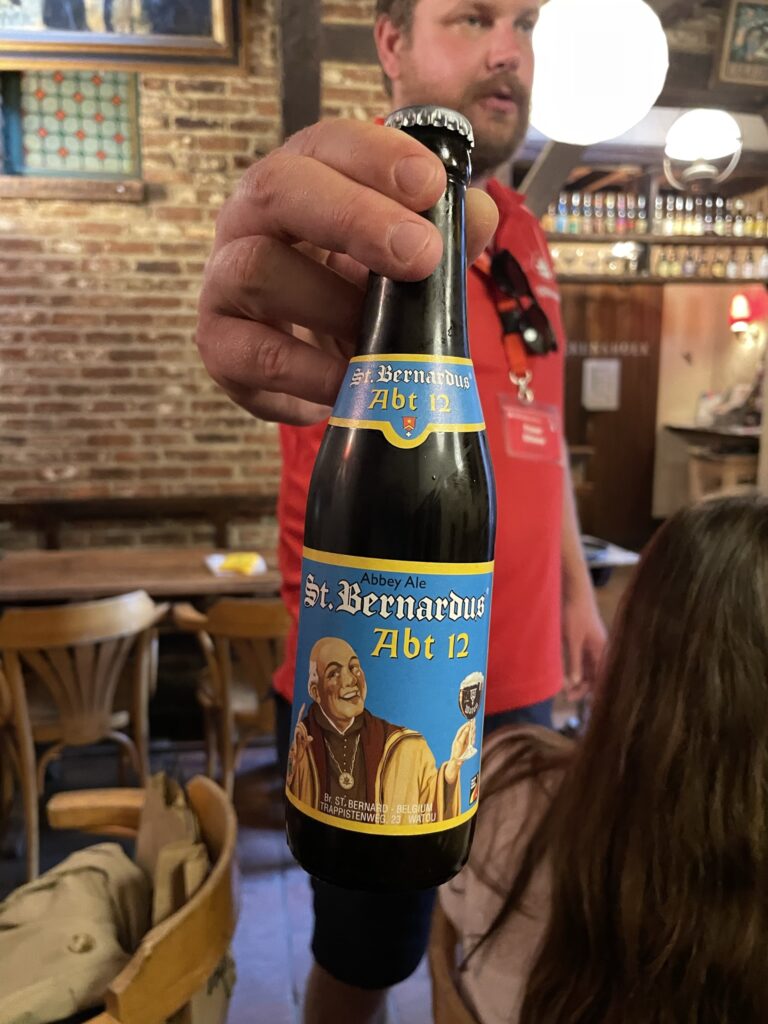
7. Take a Beer Tour
It would be a mistake to visit Brussels and not try Belgian beer. It’s not just a beverage, it’s a cultural institution that has even been recognized by UNESCO as an Intangible Cultural Heritage.
One of the best ways to learn about Belgian beer is by taking a beer tour.
There are over 1,500 different beer varieties produced in Belgium. Part of what makes Belgian brewing unique is its diversity and the traditional techniques that have been preserved for centuries.
A beer tour is certainly the best way to learn about the history, brewing techniques, and flavor profiles of the beers, but you can also do a self-guided study if you’d like. Serious beer enthusiasts should head to Cantillon Brewery, founded in 1900, one of the last traditional lambic breweries, and tour their facilities.
Bars like Delirium Café, with over 2,000 beers on offer, or À la Mort Subite, a historic establishment unchanged since the 1920s, offer a glimpse into Belgian beer culture. Ask the bartenders for recommendations as they’re usually passionate about sharing their knowledge.
8. Take a (Self-Guided) Chocolate Tour
If Belgium is known for anything, it’s beer and chocolate, which is why you can’t visit Brussels without tasting these delicious treats.
Local specialties include the praline, filled chocolate with a hard outer shell and soft interior, invented by Jean Neuhaus II in 1912, and truffles, a sweet and soft confection covered in cocoa. While you can take a guided chocolate tour, or even book a chocolate-making class, I think the best way to discover Belgian chocolate is by going from store to store and tasting different varieties.
Start in the Galeries Royales Saint-Hubert, where you’ll find Neuhaus and Chocolaterie Mary. White chocolate lovers should visit Leonidas, while dark chocolate connoisseurs should head to Galler.
As you eat pralines and truffles from around town, you’ll notice how they differ from shop to shop. Each chocolatier has their own style and signature creations, part of what makes chocolate tasting in Brussels so fun!
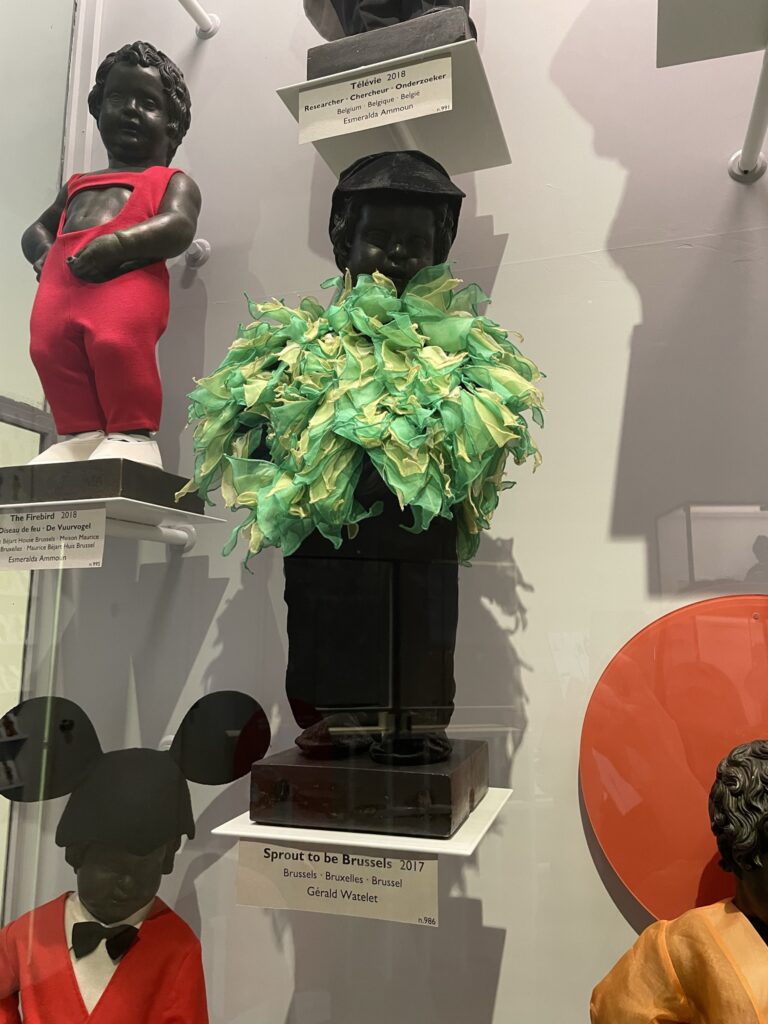
9. Garde Robe Manneken Pis
After seeing the Manneken Pis statue, you’re probably curious to see his extensive wardrobe at the GardeRobe Manneken Pis. This unique museum houses around 1,000 of the little fellow’s costumes, with about 140 on display at any given time.
In addition to displaying the costumes, the museum tells the story of how dressing the statue became a tradition. The oldest costume dates back to 1747, a gift from Louis XV of France as an apology after French soldiers stole the statue (the outfit on display is a replica as the original outfit is too fragile to show).
What makes this small museum fascinating is how the costumes reflect Brussels’ history, international relations, and evolving culture. From traditional attire from nations around the world to pop culture references like Elvis and Mickey Mouse, the collection is surprisingly diverse and entirely quirky.
10. Brussels City Museum
Located in the magnificent King’s House (Maison du Roi) on Grand Place, the Brussels City Museum gives visitors an in-depth look at the city’s rich and complex history.
The museum’s collection includes paintings, sculptures, tapestries, and artifacts that trace Brussels’ development from a medieval market town to a modern European capital. Inside is a detailed model of the city during the late Middle Ages, which is particularly fascinating.
One of the museum’s highlights is the original Manneken Pis statue (you can’t escape the guys!), safely preserved indoors after surviving various thefts and vandalism attempts over the centuries.
What I like about this museum is how it weaves together political, social, and cultural history, showing how Brussels has reinvented itself multiple times while maintaining its unique character. If you decide to go here, you’ll gain a deeper understanding of the forces that shaped modern-day Brussels.
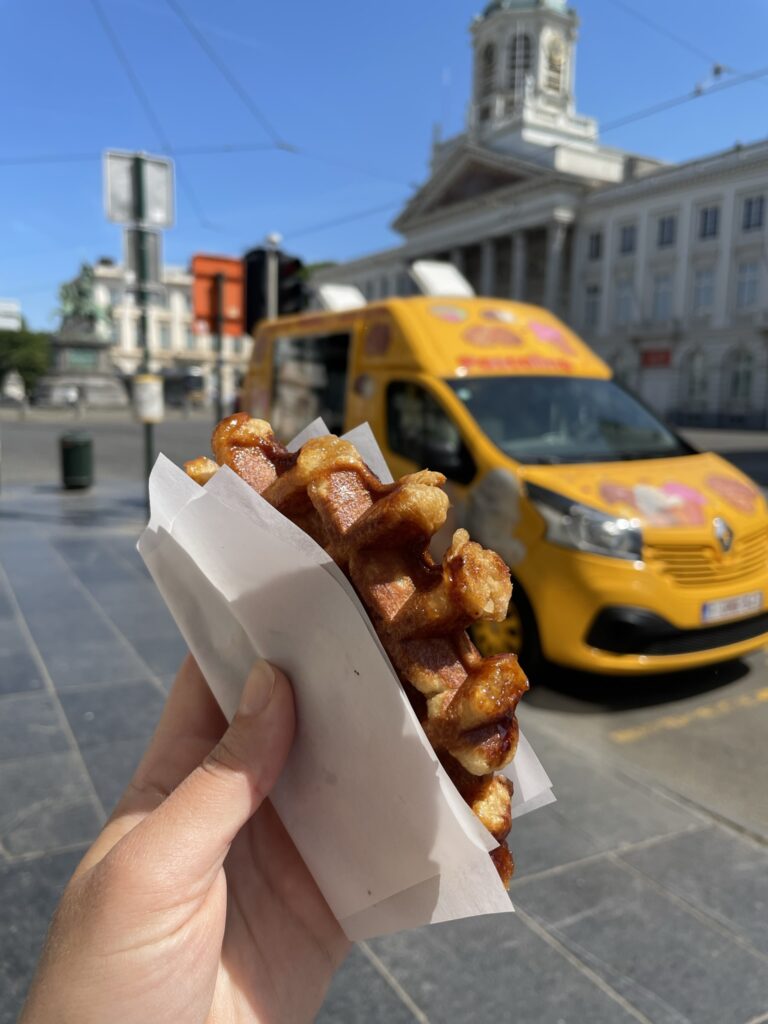
11. Eat Your Weight in Waffles
There are waffles, and then there are Belgian waffles. And within Belgium, there’s a friendly rivalry between Brussels waffles (lighter, rectangular, with deeper pockets) and Liège waffles (denser, sweeter, with caramelized sugar chunks).
Why not try both?
You’ll see waffle shops and stands everywhere you go in the city core, making this a convenient snack or late-night treat to indulge in during your visit.
For authentic Brussels waffles, try Mokafé in the Galeries Royales Saint-Hubert or Maison Dandoy, which has been making traditional Belgian biscuits and waffles since 1829. For street-style Liège waffles, the vendors around Grand Place and Manneken Pis serve them hot and fragrant.
While you should eat the waffle however you want to enjoy it, just know that the ones covered in chocolate, cream, and fruit are for tourists. Locals prefer them simple and without toppings.

12. Cathedral of St. Michael and St. Gudula
In the heart of Brussels stands this towering Gothic cathedral, The building took nearly 300 years to complete, and it was worth the wait. Dedicated to the city’s patron saints, St. Michael and St. Gudula, the cathedral has seen everything from royal weddings to state funerals. To this day it remains one of Belgium’s most important religious landmarks.
The façade is a showstopper: twin towers rising 69 meters into the sky, with a rose window that nods to its inspiration, the Cathedral of Notre Dame in Paris. Step inside and you’re greeted by soaring ribbed vaults and elegant columns that pull your gaze heavenward.
Archaeological evidence has shown that this site has been considered sacred for a long time. Excavations have unearthed the remains of a 9th-century church on this spot, and an even earlier 4th-century Roman chapel, making it one of Brussels’ oldest spiritual spots.
Sitting atop Treurenberg hill, the cathedral is hard to miss and easy to reach. It marks the border between the upper and lower town and is just a short walk from Brussels Central Station, so there’s no excuse not to swing by.

13. Eat Pommes Frites
If it feels like a lot of the things I’m recommending you do in Brussels involve eating, it’s because there are so many delicious foods to try in this city! I just don’t want you to miss out on any of them!
Belgians will passionately tell you that “French fries” are actually Belgian, and after trying authentic Belgian fries, you’ll be inclined to agree. Crunchy on the outside, creamy on the inside, and piping hot, these fries make the perfect snack to fuel a busy day of sightseeing.
The secret to Belgian frites is the double-frying method: first at a lower temperature to cook the inside, then at a higher temperature to create that perfect crispy exterior while keeping the inside fluffy. Traditionally, they’re fried in beef fat, though many places now offer vegetable oil options as well.
But of course, you can’t eat the fries plain, you have to pair them with a delicious sauce. Traditional mayonnaise is my go-to, but many shops offer different flavor combinations that you’ll just have to try for yourself.
14. BELvue Museum
Tucked right next to Brussels’ Royal Palace, the BELvue Museum is a hidden gem that gives you a crash course in Belgian history—minus the boring textbook vibe. Instead of going year by year, the museum dives into big themes like democracy, migration, and social justice, showing how all these threads weave into the fabric of modern Belgium.
What really sets the BELvue apart is how it faces the tougher parts of the country’s past. It doesn’t gloss over colonialism in the Congo or the language divides that have shaped Belgium’s politics. It leans into them and invites you to think deeper. It’s refreshing, and honestly, a little eye-opening.
Whether you’re a history buff or just curious to understand the country beyond chocolate, beer, and waffles, the BELvue delivers. The museum is compact, thoughtfully designed, and easy to explore in an hour or two—perfect for a meaningful stop during your Brussels adventure.
15. Parc du Cinquantenaire
Parc du Cinquantenaire (aka Jubilee Park) was built to mark Belgium’s 50th year of independence. The park is most famous for its photogenic triumphal arch, which reminds me of Berlin’s Brandenburg Gate.
But there’s more to this green space than just impressive architecture. The park also houses three fascinating museums: the Royal Museum of the Armed Forces and Military History, Autoworld with its jaw-dropping collection of vintage cars, and the Art & History Museum, home to everything from ancient Egyptian relics to Art Deco treasures.
Locals come to the park to run, picnic, play frisbee, or just sprawl out on the grass with a book. It’s the perfect spot to wander and forget for a moment about the bustling city you’re in.
Pro tip: Enter from the west side (coming from the city center) for the best first glimpse of the arch.
16. Palais de Justice
Perched on a hill with sweeping views over Brussels, the Palace of Justice is hard to miss—and that’s kind of the point. When it was completed in 1883 it was the largest building in the world. Even today, its massive dome and towering columns feel designed to impress (or intimidate).
The architecture is a mashup of styles all pulled together to create a monument to justice and 19th-century ambition.
Step inside (yes, you can visit the public areas. Just be prepared for airport-style security), to get a glimpse of the building’s monumental interior. Not all of it is accessible, and much of it has been under scaffolding for years, but the parts you can see are genuinely impressive.
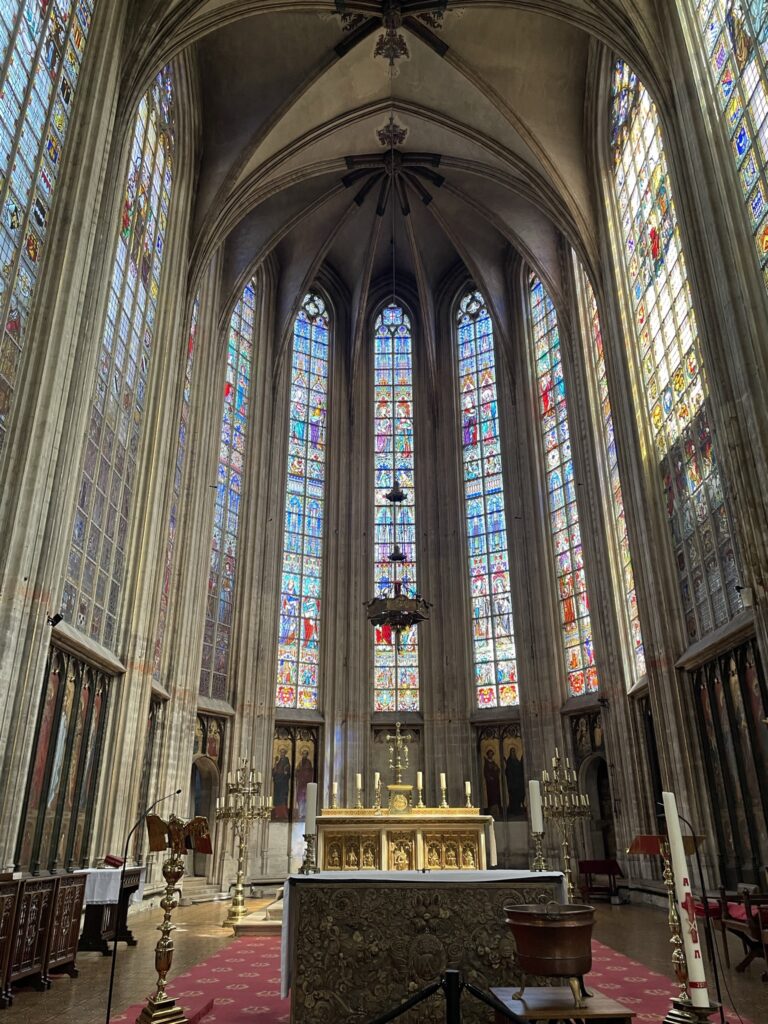
17. Église Notre-Dame des Victoires du Sablon
Located in the stylish Sablon district, this beautiful Gothic church is one of Brussels’ most underrated landmarks.
The church also comes with a story straight out of folklore. According to legend, a local woman had a vision that the Virgin Mary told her to steal a miraculous statue from Antwerp and bring it to Brussels. She did just that. In gratitude to her, a local guild built this church to house the statue.
Inside, the stained glass windows (some from the 1500s) are absolutely stunning, and the Baroque chapel is full of intricate details.
What makes this church even more special is its setting. Step outside and you’re in one of Brussels’ prettiest neighborhoods, surrounded by antique shops, artisan chocolatiers, and cozy cafés.
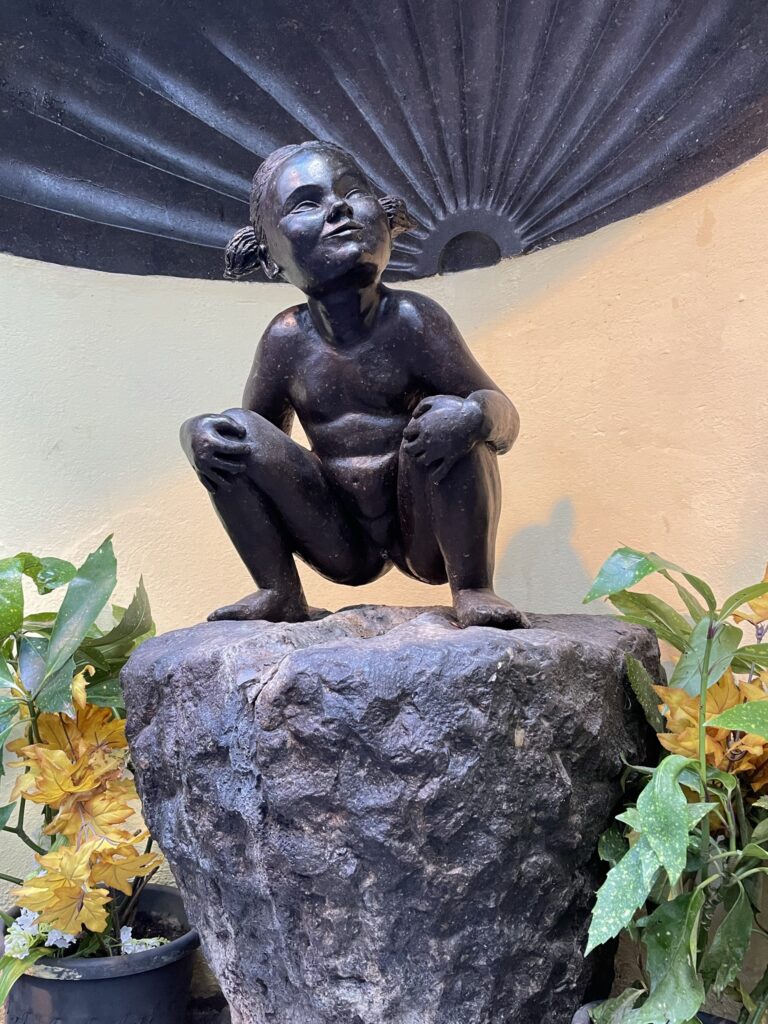
18. Jeanneke Pis and the Peeing Dog
If you found Manneken Pis charming (or bizarre), you’ll want to complete the “peeing statue trilogy” of Brussels with Jeanneke Pis and Zinneke Pis.
Jeanneke Pis was created in 1987 by Denis-Adrien Debouvrie, She is the female counterpart to Manneken Pis, a small bronze girl statue eternally squatting and urinating. She’s tucked away in a niche at the dead end of Impasse de la Fidélité, near the famous Delirium Café.
Completing the trio is Zinneke Pis, found in the Chartreux district, a statue of a dog lifting its leg to pee on a street pole. Created in 1998 by artist Tom Frantzen, the bronze dog represents the “zinneke,” a Belgian slang term for the mixed-breed dogs that used to roam the city, and by extension, the mixed heritage of Brussels residents themselves.
These statues weren’t simply built for tourists. They reflect the irreverent sense of humor of the Bruxellois. The trio has become a popular scavenger hunt for visitors, and a convenient excuse to tour through different city neighborhoods.
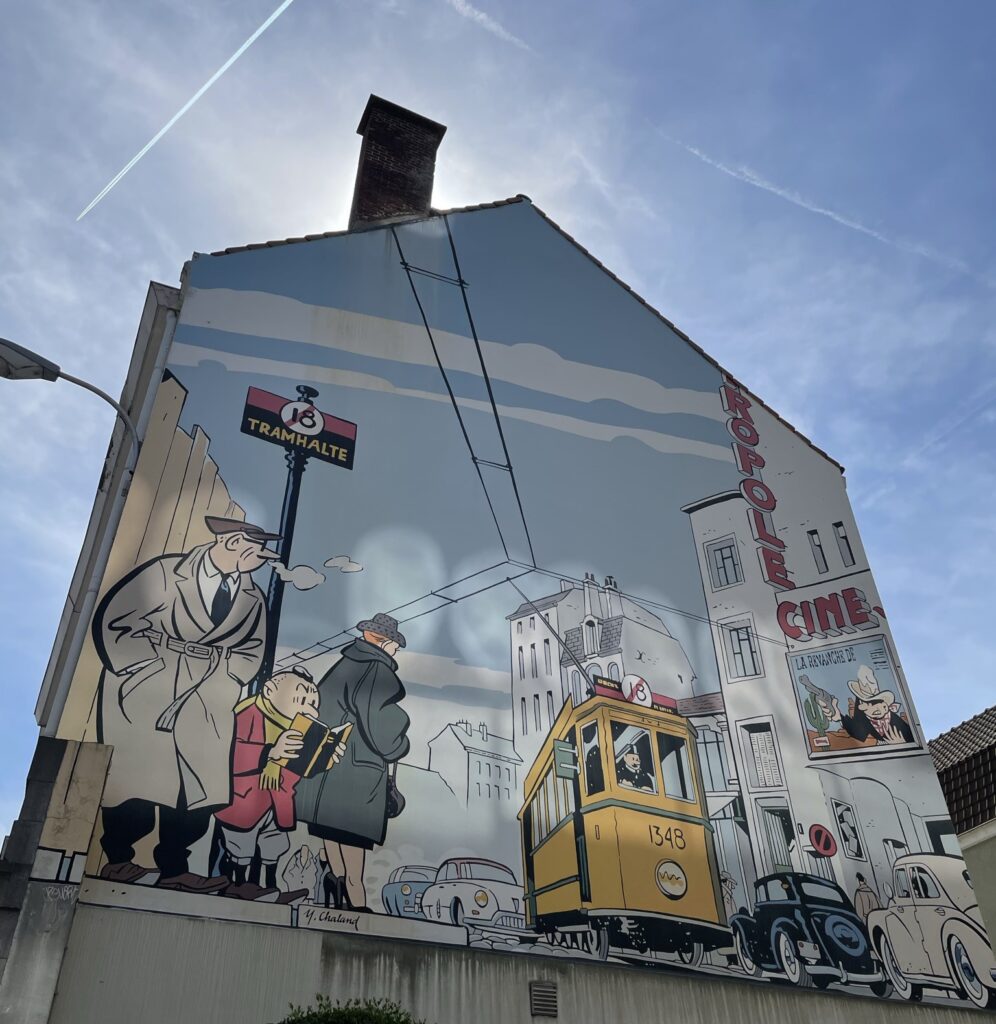
19. Comic Book Street Art
Brussels is the birthplace of some of the world’s most beloved comic characters, from Tintin to the Smurfs, and the city celebrates this heritage with a unique Comic Book Route featuring over 60 murals.
This open-air gallery began in 1991 as a project to beautify neglected walls and celebrate Belgium’s contribution to the “ninth art.” The murals range from famous characters like Lucky Luke and Asterix to lesser-known but locally cherished figures from Belgian comics.
The murals often incorporate architectural elements or span multiple stories of a building. They bring splashes of color and narrative to otherwise ordinary streets.
Some highlights include the Tintin mural on Rue de l’Etuve (near Manneken Pis), the massive Asterix wall on Rue de la Buanderie, and the Broussaille mural on Rue du Marché au Charbon.
More Things To Do In Brussels
20. Visit the Atomium
The Atomium is to Brussels what the Eiffel Tower is to Paris: an instantly recognizable symbol that was never meant to be permanent. Built for the 1958 World Expo, this massive model of an iron atom magnified 165 billion times was supposed to be dismantled after the exhibition but became too popular to remove.
The nine interconnected spheres, each 18 meters in diameter, house exhibitions on the 1950s, the World Expo, and Belgian design. The upper sphere contains a restaurant with panoramic views of Brussels that on a clear day stretch as far as Antwerp.
Five of the nine spheres are accessible to the public, connected by escalators and staircases in the tubes.
While it’s located outside the city center (you’ll have to take the metro to get there), the Atomium is worth the trip for its unique architecture and the slice of mid-century optimism it represents.
21. Visit Mini-Europe
Adjacent to the Atomium is one of Brussels’ most whimsical and family-friendly attractions: Mini-Europe. This park features over 350 meticulously crafted miniature models of famous buildings and landmarks from across the European Union. Highlights include the Acropolis of Athens to London’s Big Ben.
The attention to detail is just phenomenal. The smallest elements are just 2-3 millimeters, and many have moving parts and sound effects.
Walking through Mini-Europe is like taking a miniature grand tour of the continent in just a few hours. The models are set in landscaped gardens with information panels explaining the historical and architectural significance of each building. Interactive elements throughout the park explain how various EU institutions work and highlight cultural contributions from different member states.
22. Take a Chocolate Making Class
While sampling Belgian chocolates is essential, learning to make them yourself adds another dimension to your chocolate appreciation. Several master chocolatiers in Brussels offer workshops where you can learn the secrets behind Belgium’s most famous export.
These hands-on classes typically last 2-3 hours and cover the basics of chocolate tempering, ganache-making, and praline formation. You’ll learn about the different types of chocolate, the bean-to-bar process, and how Belgian chocolate earned its stellar reputation.
A chocolate making class is a fun, out of the box experience that gives you an opportunity to learn from chocolatiers who have often trained for years to master their craft. Also, most workshops are held in actual chocolate kitchens, giving you a behind-the-scenes look at production.
The best part? You take home your creations, usually 30-40 pieces of chocolate, that you’ve made yourself. It’s both a memorable experience and a delicious souvenir.
23. Musical Instruments Museum (MIM)
The Musical Instruments Museum (MIM) contains one of the world’s largest collections of musical instruments – over 8,000 pieces spanning centuries and continents.
This museum is incredibly immersive. Each visitor receives a pair of wireless headphones that automatically play the sound of each instrument as they approach its display.
The instrument collection ranges from familiar Western orchestral instruments to rare and unusual pieces from around the world, prehistoric instruments, and mechanical music-makers. Even visitors who aren’t particularly interested in music often find themselves captivated by this unique sensory museum experience.
24. Comics Art Museum
If you’re even slightly into comics, or just curious, the Comics Art Museum is a must-visit. Housed in a stunning Art Nouveau building designed by legendary architect Victor Horta, this museum is as much about beautiful architecture as it is about comic strips.
Inside, you’ll find a colorful tribute to Belgium’s most iconic creations, including Tintin, the Smurfs, Lucky Luke, and more. The exhibits take you behind the scenes of the comic-making process, from early pencil sketches to final panels, with lots of playful, interactive displays along the way.
Even if you’re not a hardcore comics fan, the museum is worth visiting for the behind the scenes look at this popular art form. Plus, the museum shop is fantastic for picking up unique souvenirs (hello, Tintin mugs and retro Smurf posters), and there’s an on-site café where you can recharge with a coffee and a comic in hand.
Tip: If you’re planning to hit multiple museums in Brussels, this one makes for a fun, lighthearted break between heavier history stops. Plus, it’s just a short walk from the cathedral and central station.
25. Hergé Museum
Not in Brussels but a short train ride away in nearby Louvain-la-Neuve, is the Hergé Museum. This is a pilgrimage site for fans of The Adventures of Tintin.
Even if you’re not already a devotee, this beautifully curated space offers a fascinating look into the life and creative genius of Hergé, the man behind the iconic boy reporter.
Inside, you’ll follow Hergé’s journey from his early illustration work to the full-blown Tintin phenomenon, with original drawings, storyboards, and personal artifacts that bring the artist, and his characters, to life.
The museum does an excellent job of putting Tintin into context. It’s not just as a beloved comic series, but as a cultural touchstone that’s been translated into more than 70 languages and has influenced generations of artists and writers. You’ll also get a peek at Hergé’s lesser-known work in graphic design and advertising, which is just as sharp and playful.
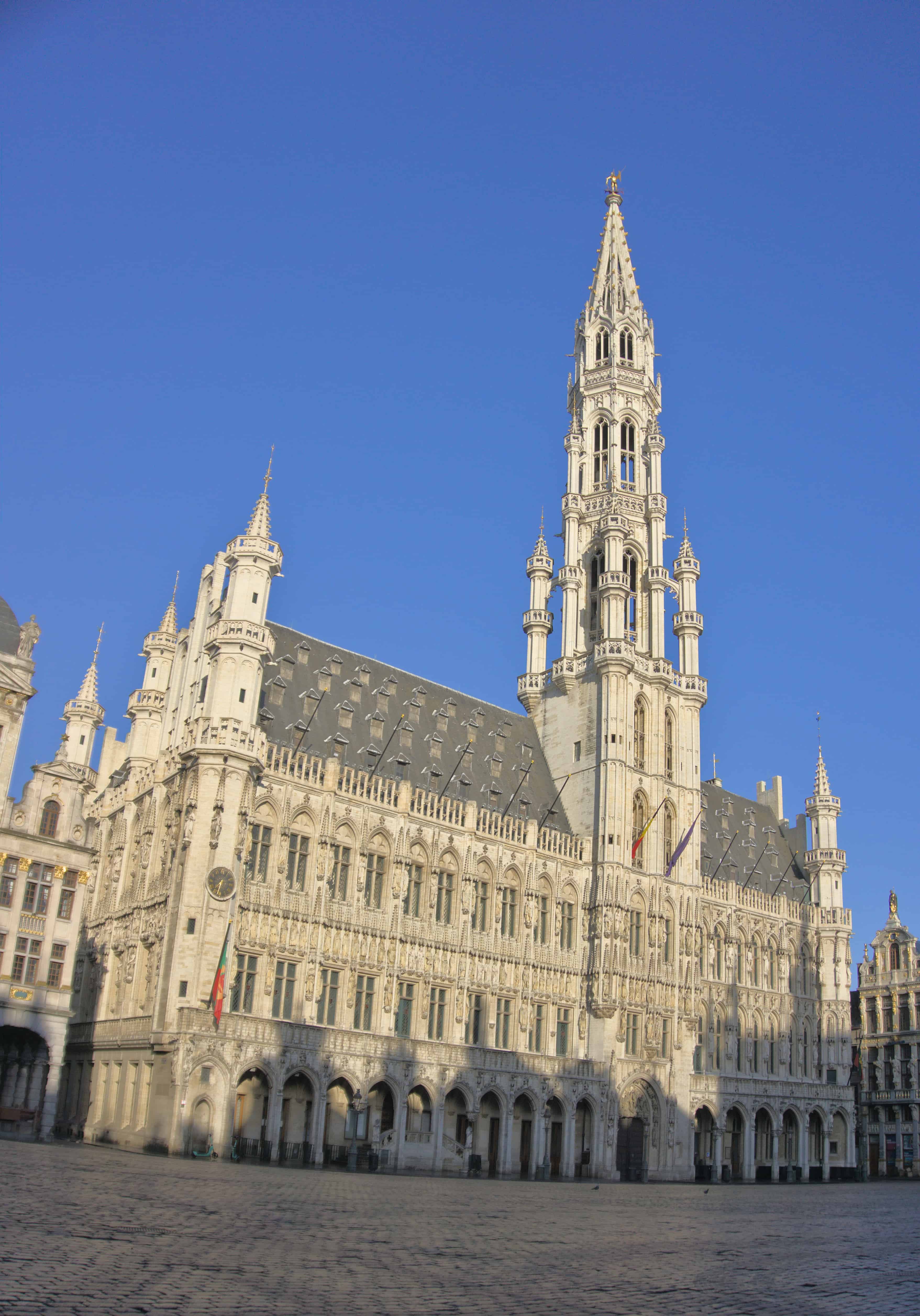
Final Thoughts on the Best Things to Do in Brussels
Brussels is a city that rewards curiosity. Whether you’re admiring the grandeur of the Grand Place, wandering into cozy alleyways filled with comic murals, or indulging in a crispy Belgian waffle fresh off the iron, Brussels is a wonderful place to visit. With its perfect blend of history, creativity, and culinary delights, there’s something for every kind of traveler.
From world-class museums and Art Nouveau masterpieces to lively markets and peaceful parks, the best things to do in Brussels showcase the city’s rich personality and quiet charm. Whether you only have one day in Brussels or are coming for a long weekend, these unforgettable experiences will leave you wanting more. So, how many sights will you check off this list?